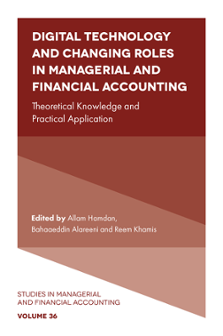
Index
ISBN: 978-1-80455-973-4, eISBN: 978-1-80455-972-7
ISSN: 1479-3512
Publication date: 29 January 2024
Citation
(2024), "Index", Hamdan, A., Alareeni, B. and Khamis, R. (Ed.) Digital Technology and Changing Roles in Managerial and Financial Accounting: Theoretical Knowledge and Practical Application (Studies in Managerial and Financial Accounting, Vol. 36), Emerald Publishing Limited, Leeds, pp. 383-393. https://doi.org/10.1108/S1479-351220240000036040
Publisher
:Emerald Publishing Limited
Copyright © 2024 Allam Hamdan, Bahaaeddin Alareeni and Reem Khamis
INDEX
- Prelims
- Part I: Tech-managerial, Fintech and Financial Innovation
- Chapter 1: Utilizing Big Data Analytics Lifecycle for Early Detection of Suspicious Financial Operations: A Proposed Model for Money Laundering Detection
- Chapter 2: The Behavioral Intention of Fintech Usage: Applying Theory of Planned Behavior in Jordan
- Chapter 3: The Role of Artificial Intelligence in Stock Forecasting in Indonesian Stock Exchange Firm
- Chapter 4: The Factoring 2.0 in the Era of the Fintech Revolution Context
- Chapter 5: Investigating the Role of Business Model Innovation in the Relationship Between Digitalization and Firm Performance
- Chapter 6: User's Continuance Intention Towards Banker's Chatbot Service – A Technology Acceptance Using SUS and TTF Model
- Chapter 7: The Value of Information and Communication Technology in Human Resource Management
- Chapter 8: The Impact of Green Innovation on the Financial Performance of Companies: Context of MENA Countries
- Part II: Digitalization of Banking Services and the Role of Managerial Accounting, Accountability, and Transparency
- Chapter 9: Service Digitalization Dimensions and Banks Competitiveness: An Institutional-Focused PLS-SEM Approach
- Chapter 10: Use of Chatbots and its Role in Enhancing Customer Experience: A Study of the Banking Industry
- Chapter 11: Factors Influencing the Mobile Banking Usage: Mediating Role of Perceived Usefulness
- Chapter 12: Business Strategy and Earnings Management: Financial Versus Non-Financial Firms
- Chapter 13: Impact of Financial Technology on Future of Banking in Bahrain: Opportunities and Challenges
- Chapter 14: The Management of Electronic Customer Relationships Through Applying 5IS Model on the Mental Image of Umniah Mobile Network Operator Company's Customers in Amman City
- Chapter 15: Financial Statements and Financial Reporting – A Narrative Embedded in Numbers, a Two Prong Philosophy – Grameen Bank & Islami Bank Bangladesh Limited (IBBL)
- Chapter 16: A Study on Behavioural Finance Investment Decisions of Investors in Bangalore
- Part III: Digital Technologies, Stakeholder Engagement, and Sustainable Reporting Practices
- Chapter 17: Firm Size, Firm Performance, and Environmental Information Disclosure Quality: Evidence from Listed A-shares Companies in China's Shanghai and Shenzhen Stock Exchanges
- Chapter 18: The Extent of Accounting Graduates' Abilities (AGAs) in Jordan to Use Modern Information Technology Systems (MITSs) to Make Optimal Financial Decisions (OFDs)
- Chapter 19: Ensuring Competitive Advantages of the Banking Sector of Ukraine in the Context of Global Digital Transformation
- Chapter 20: Culture and Business Performance of Microenterprises in the Ancash Region – Peru
- Chapter 21: Customer Satisfaction of Small Finance Banks in India
- Chapter 22: How to Manage Value Creation, Value Delivery, and Value Capture in Software Development Projects: Lessons from an ERP Software Company
- Chapter 23: The Empirical of Analysis of the Macroeconomics Variable and Financial Performance in China
- Chapter 24: Board of Directors' Characteristics and Environmental Disclosure
- Part IV: Sustainability, Big Data and Financial Management
- Chapter 25: Technologies in Sustainable Supply Chain: Insights from a Systematic Literature Review
- Chapter 26: Detecting and Preventing Fraud in Financial Transactions: A Case Study on Big Data Analysis at Kareem Exchange Company
- Chapter 27: Financial Health Analysis of Selected Public and Private-Sector Banks in India – An Altman Z-Score Approach
- Chapter 28: Impact of Remuneration Committee's Characteristics on Firm Performance
- Chapter 29: The Impact of Artificial Intelligence on Small and Medium Enterprises in Yogyakarta
- Chapter 30: Strengthening Work Engagement through Digital Human Resources Management
- Chapter 31: Orchestrating Participants of Ecosystem with the Use of Digital Technologies: Analysis in the Hospitality Industry
- Chapter 32: A Review of Internet of Things (IoT) Smart Office Data Security Threats
- Index